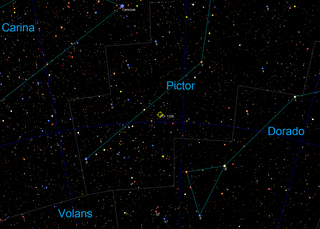TOI-1338
| Observation data Epoch J2000 Equinox J2000 | |
|---|---|
| Constellation | Pictor |
| Right ascension | 06h 08m 31.94s.[1] |
| Declination | −59° 32′ 27.55″.[1] |
| Apparent magnitude (V) | 11.975±0.025 |
| Characteristics | |
| Astrometry | |
| Radial velocity (Rv) | 24.68±8.08[2] km/s |
| Proper motion (μ) | RA: -12.258±0.037[2] mas/yr Dec.: 34.405±0.041[2] mas/yr |
| Parallax (π) | 2.4774[2] ± 0.0196[2] mas |
| Distance | 1300 ly |
| Details | |
| A | |
| Mass | 1.20[3] M☉ |
| B | |
| Mass | 0.3250[3] M☉ |
| Other designations | |
TYC 8533-950-1, EBLM J0608-59, 2MASS J06083197-5932280, RAVE J060832.0-593228 | |
| Database references | |
| SIMBAD | data |
TOI 1338 is a binary star system, discovered by TESS, and TESS's first binary system confirmed to contain a planet, called a circumbinary planet. The system is 1,300 light-years away in the constellation Pictor.[1][2] The two stars with masses of about 1.2 and 0.325 M☉ revolve around each other every 14.6 days.[3] The planet TOI 1338 b is estimated to be 6.9 Earth masses, orbiting the pair every 94 days.[4]
Nomenclature and history
The acronym "TOI" refers to stars and exoplanets studied by TESS, and is short for: "Transiting Exoplanet Survey Satellite Object of Interest".
See Also
References
- ^ a b c "ExoFOP TIC 260128333". exofop.ipac.caltech.edu. Retrieved 9 January 2020.
- ^ a b c d e f Gaia Collaboration (1 August 2018). "Gaia Data Release 2 - Summary of the contents and survey properties". Astronomy & Astrophysics. 616: A1. doi:10.1051/0004-6361/201833051. ISSN 0004-6361.
- ^ a b c Martin, David V.; Triaud, Amaury H. M. J.; Udry, Stephane; Marmier, Maxime; Maxted, Pierre F. L.; Cameron, Andrew Collier; Hellier, Coel; Pepe, Francesco; Pollacco, Don; Segransan, Damien; West, Richard (April 2019). "The BEBOP radial-velocity survey for circumbinary planets I. Eight years of CORALIE observations of 47 single-line eclipsing binaries and abundance constraints on the masses of circumbinary planets". Astronomy & Astrophysics. 624: A68. doi:10.1051/0004-6361/201833669. ISSN 0004-6361.
- ^ Reddy, Francis (6 January 2020). "TESS Discovers Its 1st Planet Orbiting 2 Stars". NASA.





